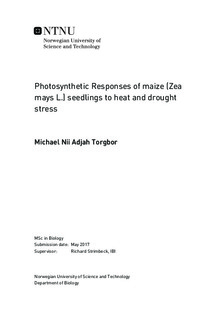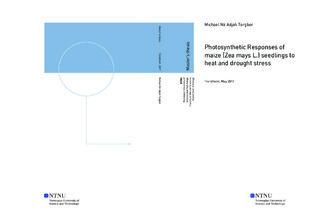| dc.description.abstract | Like all other plants, maize (Zea mays L.) depends on the environment for growth. It is also an important food source for the continuously increasing human population. However, due to the recent changes in climate, maize plants in current maize producing regions are faced with unfavorable conditions such as drought and high temperatures which adversely affect productivity. The response of plants to existing stress factors is, however, dependent on the developmental stage, duration of stress and interaction among stress factors.
The effect of temperature and moisture level on growth, photosynthetic parameters and chlorophyll fluorescence were investigated at the early seedling (young) stage of growth of two maize varieties (Obaatampa (OB) and SunSweet (SS)) from different geographic locations (tropical and temperate respectively). Seedlings were subjected to both high and low temperature under dry and moist water conditions in a 2x2x2 factorial experiment. The effect of measurement temperature on the photosynthetic responses was also determined since they were obtained at two different temperatures.
The biomass results showed that, though the varieties differed, high temperature and drought stress reduced the growth of both varieties with OB growing better than SS under low temperature. High temperature also adversely affected all the photosynthetic parameters with assimilation (A), transpiration (E) and stomatal conductance (gs) following the same trend except water use efficiency (WUE). The observed trends showed that A and E were controlled by gs.
The two varieties differed in their response to moisture with OB opening its stomata under moist conditions whiles SS did the opposite. This resulted in the difference in WUE which was better in SS as compared to OB indicating different mechanisms of survival under stress. Measurement temperature adversely affected only E and WUE at high measurement temperatures with variation in variety under different moisture treatment.
The various stress combinations didn t have any adverse effect on photosystem II, with both varieties maintaining a maximum photochemical efficiency (Fv/Fm) above 0.80 in all treatments though there were variation in varieties under the moisture treatment combinations.
In summary, results show that, although high temperature adversely affects stomatal conductance which in turn limit the Calvin cycle reaction, the varieties respond differently under contrasting moisture conditions though the plant was healthy. However, though the tropical variety (OB) was expected to perform much better than the temperate variety (SS) at high temperature, OB was just slightly better than SS at high temperature under moist conditions but much better at low temperatures. | |

